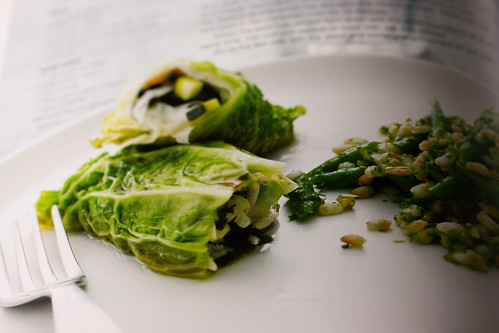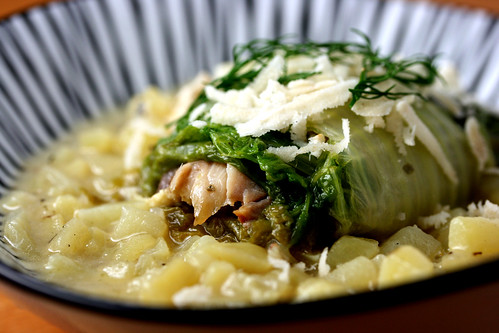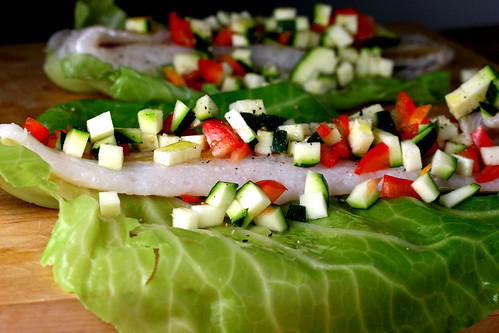The story of kåldolmar dates back to the early 1700s and offers a glimpse of Sweden’s once mighty past and tetchy relationship with its bellicose northern European neighbours. Apparently, King Karl XII, after losing the decisive Battle of Poltava in 1709 to Russia and their Polish and Norwegian allies, went into exile in a Turkish town called Bender. Whilst he was there, living off the generosity of his Ottoman allies, he spied on their warships and returned home to Sweden several years later with blueprints for a rejuvenated navy and more importantly a taste for dolmas.

Battle of Poltava (1709) painted by Denis Martens the Younger in 1726
The linguists amongst you will know that “dolma” means “stuffed thing” in Turkish which highlights the versatility of this dish. You’ll find different varieties of dolma across the old Ottoman Empire with fillings ranging from ground meat, to aubergine, courgette, peppers and rice, but typically the shell is a vine leaf. It’s hard to know which particularly style of dolma was Karl’s favourite, but from my experience of Swedes I’d guess that it was at the meatier end of the spectrum.

Dolmas from Norwichnuts on Flickr
In the chillier climes of Sweden, vine leaves were hard to come by, but Karl and his followers still hankered after the exotic taste of dolmas. So being the creative and practical nation that they are, the Swedes adapted the dish to use cabbage instead of vine leaves as a sturdy casing for the minced pork. They also switched carbs away from the rice you’ll find inside dolmas and now serve these meaty parcels with boiled potatoes, gravy and lingonberry jelly. For a decent recipe for classic Swedish Kåldolmar look no further than Annes Food.
One of my frustrations since moving across the North Sea is that the trend for smuggling enchanting tastes back from the Middle East, started by King Karl, doesn’t seem to have continued, despite the large and vibrant Middle Eastern population in Sweden. Fine, you can get donner kebab on your pizza, and plenty of curious spies in your meatballs, but so far, I haven’t found anywhere that expertly grills spiced meat over charcoals like Antepliler in Manor Park or any of the middle eastern delights you’ll find on the Edgware Road or Yottam Ottolenghi’s delis and books. Where’s the Turkish, Iranian and Iraqi version of Tayyabs in Gothenburg?
One of the most interesting recipes in the Nordic Diet cookbook sees the classic, meaty, kåldolmar given a healthy, fishy update. Trina Hahnneman kicks out the pork and replaces it with plaice, mustard, leeks and courgettes.
I gave them a twist of my own and have found the process of wrapping fish in blanched cabbage to be a very therapeutic process. The technique is pretty simple and is the basis for a wide range of healthy and delicious variations.

Smoked Mackerel Kåldolmar with Pototto (Potato Risotto)
Inspired by Marcus Sameulsson's excellent Aquavit cookbook and Trina Hahnemann's Nordic Diet
Serves 2
4 cabbage leaves
4 smoked mackerel fillets
Dijon mustard
400 grams of waxy potatoes – diced into 8mm cubes
Vegetable stock
Horseradish
Dill
1 onion
Olive oil
Butter
2 glasses of white wine
Salt and pepper
Blanch four cabbage leaves in salted water and refresh in running cold water. Allow to cool and then remove the tough stem which acts as a structural spine. This will make the leaves more foldable.
Place a mackerel fillet in the centre of each leaf and smear with a dollop of mustard and anoint with lemon zest and ground black pepper. Then wrap them up like you would with a burrito. For guidance take a look at Cheryl Marie’s blog.
Finely dice the onion and sweat in olive oil. Then add in the 8mm cubes of potato. Add a glass of white wine and then ladle in stock and stir, as you would do with a risotto. It won’t take very long to cook so keep an eye on it. Add some thyme or tarragon as you go depending on what’s to hand and what you feel like. Beat in some butter at the end and keep warm.
Place the cabbage parcels in a baking dish and pour in a glass of white wine. Cook for 10 minutes. And then serve on top of a bed of posotto with plenty of seasoning, a sprinkling of grated horseradish and a scattering of dill.

Fish parcel wrapped in cabbage from Trina Hahnneman’s Nordic Diet
Serves 2
4 cabbage leaves
400g of white fish fillets
1 courgette
1 leek
1 red pepper
Olive oil
Lemon zest
Salt and pepper
1 glass of white wine
Blanch and refresh the cabbage leaves in the same manner as the first recipe. Place a 100g piece of fish in each parcel and then add a spoonful of diced courgette, red pepper and leek. Then add a dab of butter, a dusting of lemon zest and plenty of seasoning. Then wrap them up and place them in a baking dish with a glug of olive oil and a glass of white wine.

Bake for 12 minutes until the fish is just done and serve. I partnered it with fregola, roast peppers and tomatoes which gave a sweet, red counterpoint to the savoury greens.

It works just as well with minced fish and langoustine tails. When I next have a load of langoustine or crayfish, I’ll formalise it into a recipe. Roll on "Kåldolmens dag" which celebrates the Cabbage Roll on 30 November.
4 comments:
Yummie, might give these a try for dinner tonight! I am sure the little foodie in my belly will love them too (I'm pregnant and have to eat as much healthy food and fish as possible), thanks for sharing the recipe!
Am following your blog with great interest - and am very envious of some of the places you have eaten!!! I am half-Polish,and we have a dish called 'gołębi', (which sounds like 'gerwompki' and means 'little pigeons' - because of the way they look, not because they have pigeon in them! They are very similar to your descriptions - usually filled with a mixture of pork and beef mince, and then either rice, dried fruits, chopped vegetables - whatever you have to hand really - stewed for a couple of hours in a tasty stock and served with mashed potatoes or swede, they are lovely.
@Marèsalicious - Glad you liked the recipe.
@lucyplastic - Glad you like the blog and this gołębi dish sounds very familiar. I imagine they would be great with pigeon in them.
Love the idea of rolling cabbage around the fish - looks great. Congrats on a year in Gothenburg as well
Post a Comment